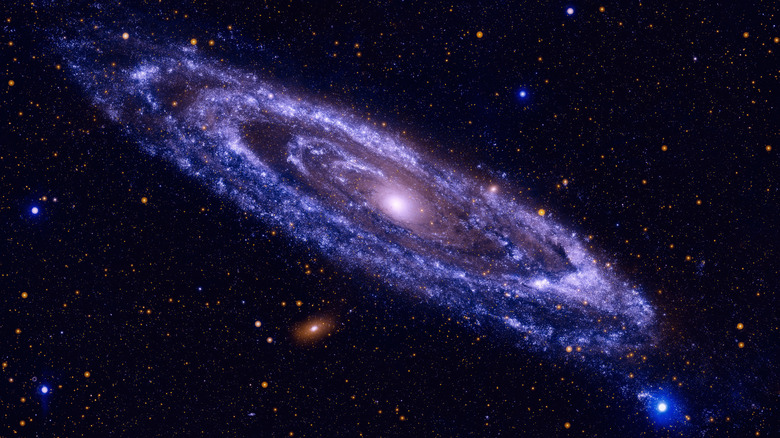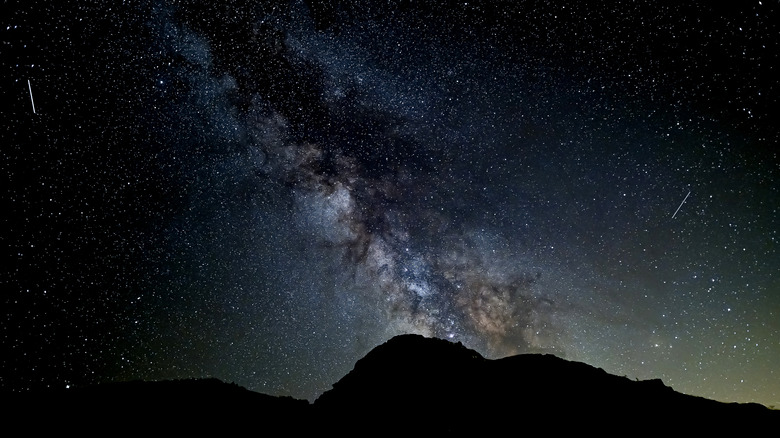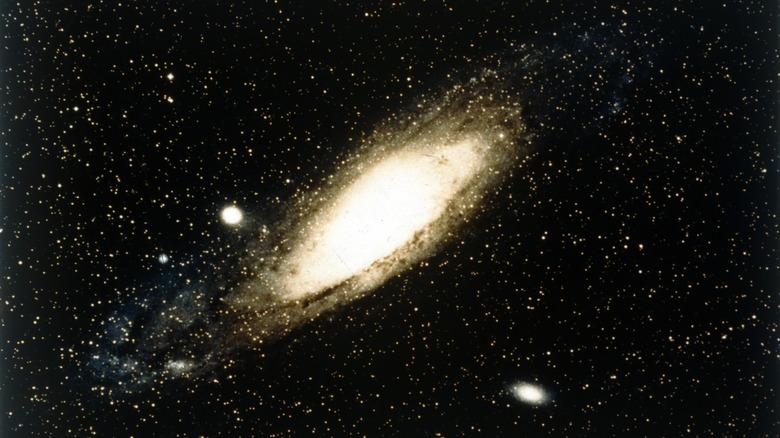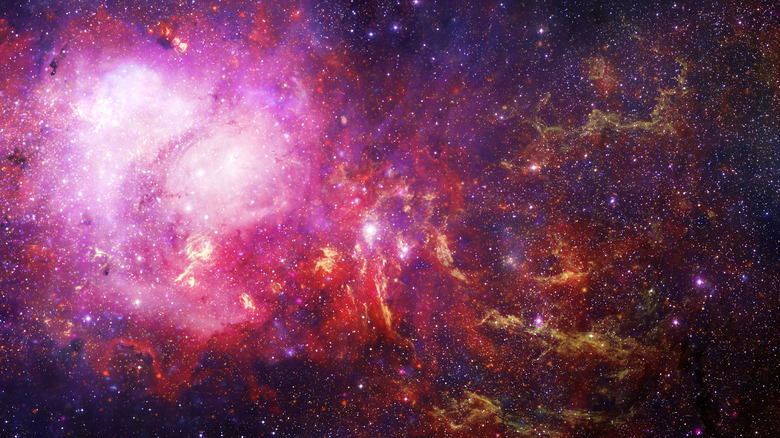What Is The Milkdromeda Galaxy?
It's very easy to get wrapped up in ultimately trivial concerns like, "Why didn't Trader Joe's have my favorite type of granola that one time out of 100 that I went?" Thanks to an evolution that rewarded such tendencies, humans have immense trouble envisioning scale and scope beyond immediate rewards or concerns. Hence climate change. Also hence: the illusion of galactic permanence.
Take axial precession. Have you ever heard about that whole "Age of Aquarius" thing that the hippies in the '60s were talking about? The Earth's axis — its tilt — wobbles like a spinning top, and shifts from 22.1 to 24.5 degrees over a span of 26,000 years, as NASA explains. As a result, the starry backdrop of the sky changes over time, and the constellation in the sky on the vernal equinox (September 21) changes about every 2,150 years. It's currently at the end of rising in Pisces. But no single person over one single lifetime would ever casually notice such a change.
Regardless of human existence, whole galaxies form, stars die, and black holes will one day reign. If we see the red giant Betelgeuse go supernova today, that means it blew up in 1473 CE because it's 548 light years away (per Sci News). Our own sun will balloon into a red giant starting 5 billion years from now (per NASA). But before then? Our entire galaxy, the Milky Way, will collide with our nearest cosmic neighbor, Andromeda.
The Milky Way has an expiration date
It's true that in comparison to a simple human life of 100 years (if you're extra, extra lucky and disease-free), the cosmos seems eternal and unchanging. Of course, in reality, the universe had a start date and has been changing ever since. About 13.8 billion years ago the Big Bang fulfilled what myths often describe as the heavens "coming from nothing" (The Hebrew and Christian Bible, Greek "chaos," Egyptian lore, and more).
Our own galaxy, the Milky Way, is actually pretty old, at 13.6 billion years, per the European Southern Observatory (ESO). The first era of the universe, the Planck Epoch, as Big Think explains, lasted a mere 10-44 seconds (10 million of a trillion of a trillion of a trillionth of a second). This is when what we know as "physics" more or less solidified. It took about 380,000 years for the first atoms to cool and cohere. They combined, combined again, aggregated, and eventually formed nebulae of gases and globular stellar clusters that condensed into stars and groups of stars called galaxies. The Milky Way, our home, as Space says, is about 100,000 light years across, and besides our sun, contains about 100 billion other stars. Our galaxy, along with Andromeda and the Triangulum galaxy, is one of the three largest galaxies in our local star cluster of 54 galaxies, as EarthSky explains.
But space itself is ever-expanding. Dark matter holds individual galaxies together, but entire galaxies shift over time.
The Andromeda Galaxy is on a collision course
The Andromeda galaxy is our closest stellar neighbor at 2.5 million light years away. On a cosmic scale, it's kind of like the town at the next exit down along the highway. In comparison, Proxima Centauri, the nearest star in our own galaxy at a mere 4.25 light years away, is like your neighbor over the fence.
Andromeda, also known as Messier 31 (M31), is a spiral galaxy like the Milky Way, but without our galaxy's loose-looking "barred arms" to either side. As EarthSky says, Andromeda is the largest galaxy in our local cluster, and has at its center a supermassive black hole just like the Milky Way. It's unclear where the black hole is located, as NASA explains, but there are currently 35 potential locations. And somewhere between the Milky Way and Andromeda lies the heart of our local cluster of 54 galaxies, around which they all revolve.
Long before our sun expands into a red giant, our two galaxies will start to merge. As Kottke illustrates, about 2 billion years from now Andromeda — the entire galaxy of 1 trillion stars, per Astronomy – will start to be visibly large in our night sky. It'll grow and grow until it fills the heavens, and in 7 billion years the sky will look completely different. The supermassive black holes at our galaxies' centers will form a binary core, eventually fuse, and one mega-galaxy will emerge: Milkdromeda.
Milkdromeda: the merger of Andromeda and the Milky Way
It's unclear what kind of life will exist on Earth within 4 billion years, if any, near the beginning of the Milky Way-Andromeda merger. Thanks to computer models, though, we know we will look up from the surface of Earth at that point and stare at a change so gradual it's unknown whether or not anyone would realize it happened, much like a meager 2,150-year-long shift into the Age of Aquarius.
Space reveals how researchers at Pennsylvania State University have developed an AI-driven computer model to map the birth of Milkdromeda, taking dark matter (an attractive force) and dark energy (an expansive force) into account. The model even reveals "dark-matter filaments that bridge the two galaxies and that may affect the merger." In fact, the model depicts not only the creation of Milkdromeda, but the fate of 17,000 other galaxies within 600 million light years of the Milky Way, including "local void" regions between galaxies where there is absolutely nothing at all.
Strictly speaking, on a galactic scale, the galaxies are already starting to merge. As EarthSky shows, Andromeda is so big that if it were brighter, it would look about six times as big as the moon, clear and shimmering in the night sky. And the whole thing is moving toward us about as fast as a car on a highway, 110km (70 mph). No worries about any individual stars colliding, though, including our sun. Space is simply full of too much space.



